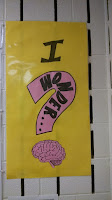This year I am focusing on cultivating intentional discussion and self
assessment in our music class. That began with the introduction of our
discussion starter posters (seen below). Students are encouraged to use
this language whenever they would like to contribute to discussion. For
example, students can use the "I Notice..." poster any time we are
discussing what music looks or sounds like and how it connects to what
we already know. Students might say, "I noticed that this song has a
pattern in the rhythms" or "I noticed that every phrase ends with a
rest."

This is also a great way for students to use supportive language when critiquing others, while being specific and direct. Students might praise others by saying "I noticed that John remembered to go to rest position when he was done playing." When giving constructive criticism, "I noticed that Mary didn't bounce her mallets, which is why her xylophone did not sound right," sounds a lot kinder than "Mary doesn't know how to play her xylophone the correct way."

This is also a great way for students to use supportive language when critiquing others, while being specific and direct. Students might praise others by saying "I noticed that John remembered to go to rest position when he was done playing." When giving constructive criticism, "I noticed that Mary didn't bounce her mallets, which is why her xylophone did not sound right," sounds a lot kinder than "Mary doesn't know how to play her xylophone the correct way."
The "I Predict..." poster will help students think ahead about their
performance or make a hypothesis about what a piece of music might sound
like.
The "I Value..." poster helps students voice their opinion and connect
to something they observe that they really like or enjoy about a piece
of music or a peer's performance. I will be using this language to help
students understand what I am looking for in a thoughtful performance or
as a way to praise students for taking an academic risk.
Finally, the "I Wonder..." poster will encourage students to share their confusions, questions or "out-of-the-box" thinking. The phrase "I wonder" allows students to share their ideas while not feeling like they are being judged on whether they are right or wrong.
Another goal I have for the year is to have students mindfully use self
critique when dealing with performance tasks. We are using a three point
critique system (explained below). During class, there will be times
when we quickly show a 1, 2, or 3 with our fingers so students can
express their comfort level with a new skill. Other times we may fill
out critique forms. When using the forms, I am able to write notes to
the students, such as helpful hints or words of encouragement to help
them grow as musicians.
We all start as beginners, but some students are able to master concepts
and skills at a faster rate. A number 1 or Beginner level means the
student needs help from the teacher or a friend to be successful.
Beginners may be given the option of performing a skill that fits the
music but is on a level under the given task in order to have them
experience success.
Sometimes we don't need help but we do need more practice at a skill or
concept. A number 2 means students are on their way to mastering a skill
or concept, but have not arrived at Independence.
Independent students have mastered skills or concepts. Students who are a
"3" do not need help or practice. Independent students may be given
challenges, such as adding another layer to the song's harmony.





